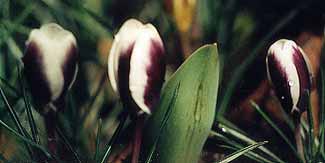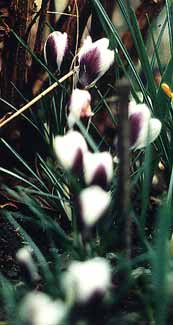 | |
|
Out of the frozen earth below, Out of the melting of the snow, No flower, but a film, I push to light; No stem, no bud, — yet I have burst The bars of winter, I am the first, O Sun, to greet thee out of the night! Bare are the branches, cold is the air, Yet it is fire at the heart I bear, I come, a flame that is fed by none: The summer hath blossoms for her delight, Thick & dewy & waxen-white, Thou seest me golden, O golden Sun! Deep in the warm sleep underground Life is still, & the peace profound: Yet a beam that pierced, & a thrill that smote Call'd me & drew me from far away; — I rose, I came, to the open day Have won, unshelter'd, alone, remote. No bee strays out to greet me at morn, I shall die ere the butterfly is born, I shall hear no note of the nightingale; The swallow will come at the break of green, He will never know that I have been Before him here when the world was pale. They will follow, the rose with the thorny stem, The hyacinth stalk, — soft airs for them; They shall have strength, I have but love: They shall not be tender as I, — Yet I fought here first, to bloom, to die, To shine in his face who shines above. O Glory of heaven, O Ruler of morn, O Dream that shap'd me, & I was born In thy likeness, starry, & flower of flame; I lie on the earth, & to thee look up, Into thy image will grow my cup, Till a sunbeam dissolve it into the same. -The Crocus, | |
Crocus chrysanthus
'Prince Claus'
'Prince Claus' (properly 'Prinz Claus,' introduced by C. M. Berbee of Stolpen, The Netherlands, in 1959) is one of the more stunning of our croci, very uniquely colored.
Each petal is white on the inside, & also white on the top portion of the outer petals, but a very deep navy purple on the bottom half or third. Some of them have a faint dusting of blue on the interior.
It's a Bunch-Flowering Crocus, so-named because individual bulbs are frequently multiflowering, hence a drift started with twenty-five bulbs can look very densely planted even for its first year. As it naturalizes & produces offsets, it will be still flowerier in years to come.
Ours begins to express itself in full bud the second week in February, a week after the abutted drift of orange-gold C. c. 'Goldilocks.' For the rest of February, the strongly contrasting drifts bloom together, with 'Prince Claus' lasting into much of March.
The area of these two crocuses also has several naturalized snow crocuses of various colors that were planted long ago, so that the distinct drifts are interupted by light cream-colored, light luminscent blue, deep purple, white, & yellow crocuses other than the 'Stellaris.' There are also naturalized tulips, scillas, & other odd things most of which were planted by some previous owner of our house & which return each spring.
 'Prince Claus' is located at the foot of a Diablo Ninebark. Though the Diablo is deciduous, & crocuses do nicely under deciduous shrubs that are leafless when the crocuses most need the sun, the Diablo is so densely twigged that it possibly provides too much shade for 'Prince Claus.'
'Prince Claus' is located at the foot of a Diablo Ninebark. Though the Diablo is deciduous, & crocuses do nicely under deciduous shrubs that are leafless when the crocuses most need the sun, the Diablo is so densely twigged that it possibly provides too much shade for 'Prince Claus.'This crocus does excellently even so, but nearly all croci remain closed on overcast days, & I've noticed the 'Prince Claus' is closed a few days more than is the case with the nearby 'Stellaris' which, being under the airier limbs of the deciduous Oyama magnolia, gets a great deal more light this time of year.
On a sunny day 'Prince Claus' is so wide open that the purple-blue blotches on the outside are invisible, & it appears to be a strikingly bright all-white crocus. On overcast days when the petals remain partially closed, the blotches are fully visible. It's kind of like having two different crocuses that take turns in that location.
The cultivar name is for His Royal Highness Prince Claus of the Netherlands (1926-2002), born Claus von Amsberg, consort of Queen Beatrix of the House of Orange. Though a German aristocrat by birth, he was suprisingly humble as royalty go, & was noted during his lifetime for his support of the arts & culture.